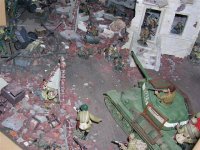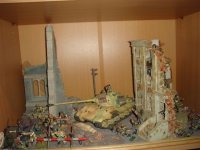You are using an out of date browser. It may not display this or other websites correctly.
You should upgrade or use an alternative browser.
You should upgrade or use an alternative browser.
berlijn 1945 (1 Viewer)
- Thread starter hoogri
- Start date
Warrior
Lieutenant General
- Joined
- May 12, 2005
- Messages
- 15,170
Richard,
Thanks for posting these, they all look terrific, my favorite is the middle one, it really has that last desperate stand feel to it; are there anymore pictures of that one you could post at some point.
Thanks for sharing........
Thanks for posting these, they all look terrific, my favorite is the middle one, it really has that last desperate stand feel to it; are there anymore pictures of that one you could post at some point.
Thanks for sharing........
nasirkasmani
Sergeant Major
- Joined
- Oct 19, 2007
- Messages
- 1,872
k&C really aught to address the east front as it is very obvious that there are many fans of the main theater of WW2.
excellent work everybody.
excellent work everybody.
Cyber Field Marshall
Sergeant Major
- Joined
- Jan 2, 2009
- Messages
- 1,608
Agreed. Good dioramas hoogri. Perhaps the Soviets don't sell well but clearly a small lineup of a few here and there wouldn't hurt? The Germans from our polls clearly are popular so why not make pieces that collectors can interchange between Eastern and Western front situations, just like in hoogri's dioramas, the Normandy pieces interchange well (ex. 88mm and crew). Just a thought, I know the purists may not like it.
Flammenpanzer
Specialist
- Joined
- Apr 23, 2005
- Messages
- 295
It is strange the Russians did not sell that well, I think they have some of the best poses in their sets compared to the U.S. or Germans.
Warrior
Lieutenant General
- Joined
- May 12, 2005
- Messages
- 15,170
"really like the building in the first photo (is that from a manufacturer or made from scratch"
Colin,
That building used to be sold through K & C Uk, I was lucky enough to get a few of them several years ago, my customers loved them. They were actually kits made of resin that you had to glue together, nothing complicated at all.
I think the guy they were getting them from stopped making them, I could be wrong..............
Colin,
That building used to be sold through K & C Uk, I was lucky enough to get a few of them several years ago, my customers loved them. They were actually kits made of resin that you had to glue together, nothing complicated at all.
I think the guy they were getting them from stopped making them, I could be wrong..............
fmethorst
Command Sergeant Major
- Joined
- Feb 18, 2008
- Messages
- 2,436
Richard,
Thanks for posting these, they all look terrific, my favorite is the middle one, it really has that last desperate stand feel to it; are there anymore pictures of that one you could post at some point.
Thanks for sharing........
I was thinking exactly the same thing. Excellent scene.
fmethorst
Command Sergeant Major
- Joined
- Feb 18, 2008
- Messages
- 2,436
Agreed. Good dioramas hoogri. Perhaps the Soviets don't sell well but clearly a small lineup of a few here and there wouldn't hurt? The Germans from our polls clearly are popular so why not make pieces that collectors can interchange between Eastern and Western front situations, just like in hoogri's dioramas, the Normandy pieces interchange well (ex. 88mm and crew). Just a thought, I know the purists may not like it.
Actually the Germans aren't the problem. Many of the Normandy and Bulge Germans can be transfered to eastern front scenes. It's the lack of opposition that presents the challenge.
fmethorst
Command Sergeant Major
- Joined
- Feb 18, 2008
- Messages
- 2,436
I recently received this book covering the battle and so far it has been fantastic.

http://www.rzm.com/books/hel/hp3125.cfm

http://www.rzm.com/books/hel/hp3125.cfm
nasirkasmani
Sergeant Major
- Joined
- Oct 19, 2007
- Messages
- 1,872
I recently received this book covering the battle and so far it has been fantastic.

http://www.rzm.com/books/hel/hp3125.cfm
frank,
have you read this book?
i'm very much interested and will value your review of this book.
sincerely.
Attachments
debrito
Command Sergeant Major
- Joined
- Jul 9, 2007
- Messages
- 2,435
Actually the Germans aren't the problem. Many of the Normandy and Bulge Germans can be transfered to eastern front scenes. It's the lack of opposition that presents the challenge.
Well said Frank....
fmethorst
Command Sergeant Major
- Joined
- Feb 18, 2008
- Messages
- 2,436
frank,
have you read this book?
i'm very much interested and will value your review of this book.
sincerely.
I'm still in the first section (Prelude) but this is an impressive work providing both high level and detailed information about the final assault on Berlin and the defeat of the Nazi regime. There are maps/aeriel photgraphs of the various districts throughout the assault with unit positions along with the photos and text.
The stunning Soviet losses are a testament to the Soviet contempt of human life in conjunction with their crude tactics. I found one excerpt attributed to a conversation between Zhukov and Eisenhower particularly indicative of the Soviet mentality. Zhukov's description of the Soviet method of dealing with minefields, "There are two types of mines; one is the personnel mine and the other is the vehicular mine. When we come to a minefield our infantry attacks exactly as if it were not there. The losses we get from personnel mines we consider only equal to those we would have gotten from machine guns and artillery if the Germans had had chosen to defend that particular area with strong bodies of troops instead of with mine fields
Some interesting Soviet casualty statistics:
Berlin Operation (April 16 1945 - May 8 1945, 23 days) - The bulk of the fighting was done by May 2 so daily losses were actually higher than reported for the entire operation since these are averaged.
Total Soviet force: 2,062,100 (including 155,900 Poles)
Total Soviet casaulties (killed, sick and wounded): 361,367 (17.5%)
This works out to 15,000 soldiers or the equivalent of a WWII U.S. Infantry division per day of operation.
Total Small Arm losses: 215,900 (9,400 per day)
Total Tank and Self Propelled Gun losses: 1,997 (87 per day)
Totsl Guns and Mortar losses: 2,108 (92 per day)
Total Aircraft losses: 917 (40 per day)
Compare the armor losses with Kursk (19 day operation)
Total Tank and Self Propelled Gun losses: 1,614 (84 per day)
Users who are viewing this thread
Total: 2 (members: 0, guests: 2)





